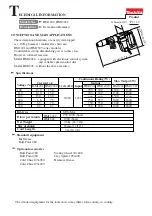
6 - Introduction to Programming
70
Multiple Commands in a Message
Multiple SCPI commands can be combined and sent as a single message with one message terminator.
There are two important considerations when sending several commands within a single message:
♦
Use a semicolon to separate commands within a message.
♦
There is an implied header path that affects how commands are interpreted by the dc source.
The header path can be thought of as a string that gets inserted before each command within a message.
For the first command in a message, the header path is a null string. For each subsequent command the
header path is defined as the characters that make up the headers of the previous command in the
message up to and including the last colon separator. An example of a message with two commands is:
OUTP:STAT ON;PROT:DEL 2
which shows the use of the semicolon separating the two commands, and also illustrates the header path
concept. Note that with the second command, the leading header "OUTP" was omitted because after the
"OUTP:STAT ON" command, the header path was became defined as "OUTP" and thus the instrument
interpreted the second command as:
OUTP:PROT:DEL 2
In fact, it would have been syntactically incorrect to include the "OUTP" explicitly in the second
command, since the result after combining it with the header path would be:
OUTP:OUTP:PROT:DEL 2
which is incorrect.
Moving Among Subsystems
In order to combine commands from different subsystems, you need to be able to reset the header path to
a null string within a message. You do this by beginning the command with a colon (:), which discards
any previous header path. For example, you could clear the output protection and check the status of the
Operation Condition register in one message by using a root specifier as follows:
OUTPut:PROTection:CLEAr;:STATus:OPERation:CONDition?
The following message shows how to combine commands from different subsystems as well as within
the same subsystem:
VOLTage:LEVel 20;PROTection 28;:CURRent:LEVel 3;PROTection:STATe ON
Note the use of the optional header LEVel to maintain the correct path within the voltage and current
subsystems, and the use of the root specifier to move between subsystems.
Including Common Commands
You can combine common commands with system commands in the same message. Treat the common
command as a message unit by separating it with a semicolon (the message unit separator). Common
commands do not affect the header path; you may insert them anywhere in the message.
VOLTage:TRIGgered 17.5;:INITialize;*TRG
OUTPut OFF;*RCL 2;OUTPut ON
















































